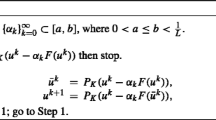Abstract
This paper presents a continuation method for monotone variational inequality problems based on a new smooth equation formulation. The existence, uniqueness and limiting behavior of the path generated by the method are analyzed.
Similar content being viewed by others
References
A. Auslender, “Numerical methods for nondifferentiable convex optimization,”Mathematical Programming Study 30 (1987) 102–126.
A. Auslender, J.P. Crouzeix and P. Fedit, “Penalty-proximal methods in convex programming,”Journal of Optimization and Applications 55 (1987) 1–21.
M.S. Bazaraa and C.M. Shetty,Nonlinear Programming: Theory and Algorithms (Wiley, New York, 1979).
B. Chen and P.T. Harker, “A non-interior-point continuation method for linear complementarity problems,”SIAM Journal of Matrix Analysis and Applications 14 (4) (1993) 1168–1190.
B. Chen and P.T. Harker, “A non-interior-point continuation method for quadratic and linear programs,”SIAM Journal of Optimization 3 (3) (1993) 503–515.
R. De Leone and O.L. Mangasarian, “Serial and parallel solution of large scale linear programs by augmented Lagrangian successive overrelaxation,” Technical Report No. 701, Computer Science Department, University of Wisconsin, Madison, WI, 1987.
A.V. Fiacco and G.P. McCormick,Nonlinear Programming: Sequential Unconstrained Minimization Techniques (Wiley, New York, 1968).
M. Fukushima, “An outer approximation algorithm for solving general convex program,”Operations Research 31 (1982) 101–113.
M. Fukushima, “Equivalent differentiable optimization problems and descent methods for asymmetric variational inequality problems,”Mathematical Programming 59 (1992) 99–110.
P.T. Harker and J.-S. Pang, “Finite-dimensional variational inequality and nonlinear complementarity problems: a survey of theory, algorithms and applications,”Mathematical Programming 48 (1990) 161–220.
A.A. Kaplan, “On convex programming with internal regularization,”Soviet Mathematics 19 (1975) 795–799.
M. Kojima, S. Mizuno and T. Noma, “A new continuation method for complementarity problems with uniformP-functions,”Mathematical Programming 43 (1989) 107–113.
M. Kojima, S. Mizuno and T. Noma, “Limiting behavior of trajectories generated by a continuation method for monotone complementarity problems,”Mathematics of Operations Research 15 (1990) 662–675.
M. Kojima, S. Mizuno and T. Noma, “Homotopy continuation methods for complementarity problems,”Mathematics of Operations Research 16 (1991) 754–774.
M. Kojima, S. Mizuno and A. Yoshie, “A polynomial-time algorithm for a class of linear complementarity problems,”Mathematical Programming 44 (1989) 1–26.
J. Kyparisis, “Sensitivity analysis for nonlinear programs and variational inequalities with nonunique multipliers,”Mathematics of Operations Research 15 (1990) 286–298.
O.L. Mangasarian, “Equivalence of the complementarity problem to a system of nonlinear equations,”SIAM Journal on Applied Mathematics 31 (1976) 89–92.
O.L. Mangasarian, “Iterative solution of linear programs,”SIAM Journal of Numerical Analysis 18 (1981) 606–614.
O.L. Mangasarian and M.V. Solodov, “Nonlinear complementarity as unconstrained and constrained minimization,” Technical Report No. 1074, Computer Sciences Department, University of Wisconsin, Madison, WI, 1992.
B. Martinet, “Régularization d'inéquations variationnelles par approximation successives,”RAIRO 4 (1970) 154–159.
L. McLinden, “The complementarity problem for maximal monotone multifunctions,” in: R.W. Cottle, F. Giannessi and J.L. Lions, eds.,Variational Inequalities and Complementarity Problems (Academic Press, New York, 1980) pp. 251–270.
L. McLinden, “Stable monotone variational inequalities,”Mathematical Programming 18 (1990) 303–338.
J.-S. Pang, “A posteriori error bounds for linearly constrained variational inequality problems,”Mathematics of Operations Research 12 (1987) 474–484.
J.-S. Pang and S.A. Gabriel, “NE/SQP: A robust algorithm for the nonlinear complementarity problem,”Mathematical Programming 60 (1993) 295–337.
J.-S. Pang and Z.P. Wang, “Embedding methods for variational inequality and nonlinear complementary problems,” manuscript, Department of Mathematical Sciences, The Johns Hopkins University, Baltimore, MD, 1989.
R.T. Rockafellar, “Augmented Lagrangian and application of the proximal point algorithm in convex programming,”Mathematics of Operations Research 1 (1976) 97–116.
R.T. Rockafellar, “Monotone operators and the proximal point algorithm,”SIAM Journal on Control and Optimization 14 (1976) 877–898.
L.T. Watson, “Solving the nonlinear complementarity problem by a homotopy method,”SIAM Journal on Control and Optimization 17 (1979) 36–46.
S. Wright, “Implementing proximal point methods for linear programming,” Technical Report, Department of Mathematics, North Carolina State University, Raleigh, NC, 1989.
Author information
Authors and Affiliations
Additional information
This work was supported by the National Science Foundation Presidential Young Investigator Award ECE-8552773 and by a grant from the Burlington Northern Railroad.
Rights and permissions
About this article
Cite this article
Chen, B., Harker, P.T. A continuation method for monotone variational inequalities. Mathematical Programming 69, 237–253 (1995). https://doi.org/10.1007/BF01585559
Received:
Revised:
Issue Date:
DOI: https://doi.org/10.1007/BF01585559



